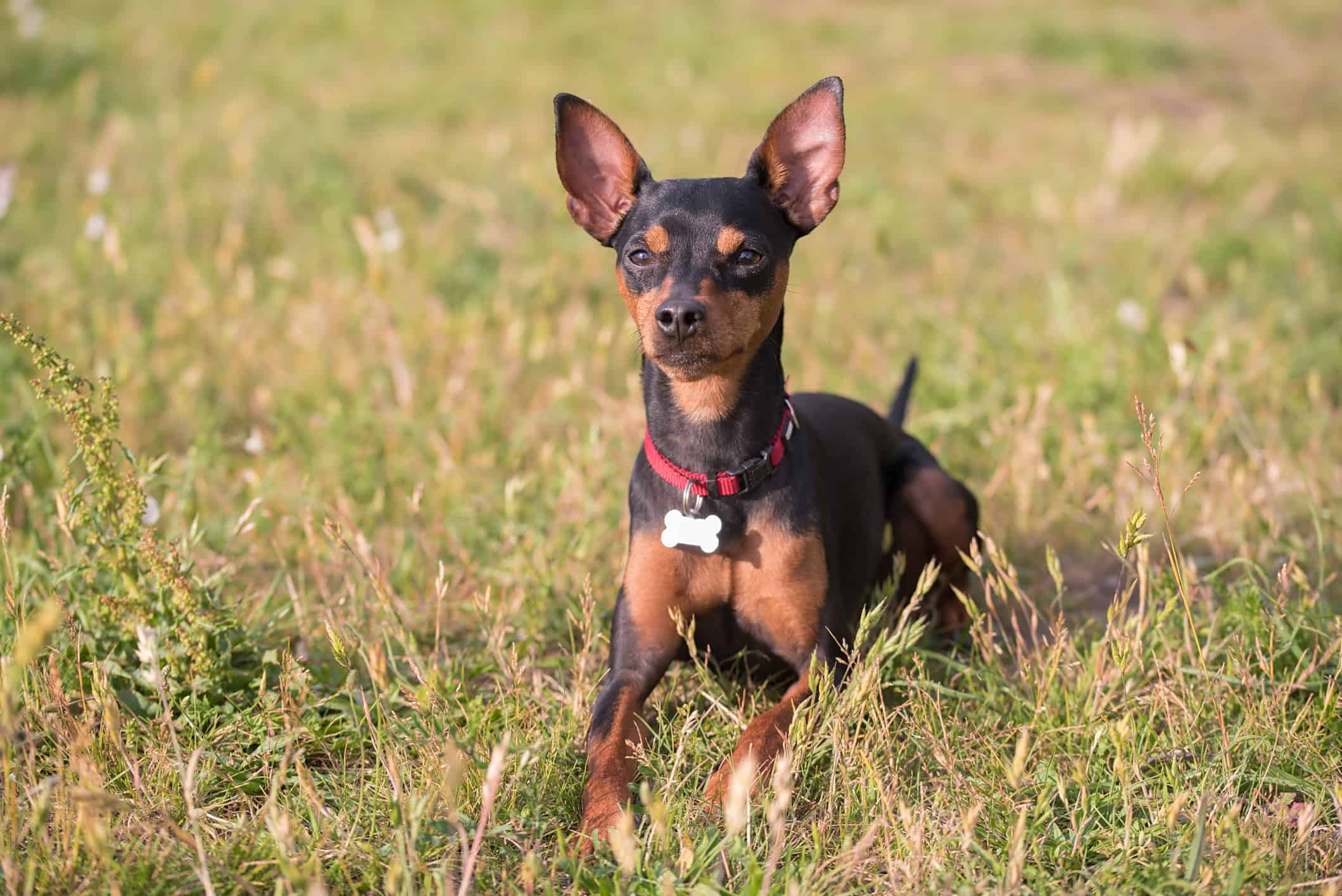With a regal nickname, a trademark gait, and a fearless attitude, the miniature pinscher makes a great family dog. They’re small but mighty dogs that love their families and have a “social butterfly” personality. Life remains an exciting adventure for miniature pinscher-owning families with their trusty and loyal pup at their side. Despite common thought, the miniature pinscher isn’t a “miniature version” of the Doberman. It’s a completely separate breed.
For current and future owners of miniature pinschers, here’s a handy guide with comprehensive information about the growth, behavioral milestones, and training tips for the breed.
Miniature Pinscher Summary

Min pins enjoy being close to their humans.
©javitrapero/iStock via Getty Images
According to the American Kennel Club, the miniature pinscher, “King of Toys,” or “min pin” remains among the top 100 most popular breeds in America. They’re a big dog in a small dog body — bringing fearlessness, fun, and protectiveness to the table.
The breed comes in six standard colors, which are combinations of black, tan, and red, but also vary between colors like fawn, rust, chocolate, and blue stag. Min pins don’t often need to be groomed thanks to their short coat. They do, however, need ample exercise to keep their mind and body active. The breed’s signature long legs help them play hard and fast at games like hide and seek or tag.
Miniature Pinscher Growth and Weight Chart by Age
While individual dogs vary, the chart below provides a general range of the male and female weights of miniature pinschers throughout the first two years of their lives.
| Age | Male Weight | Female Weight |
|---|---|---|
| Birth | 8.4 ounces | 8 ounces |
| 1 Month | 1.4 pounds | 1 pound |
| 6 Weeks | 2.7 pounds | 2.5 pounds |
| 2 Months | 3.9 pounds | 3.1 pounds |
| 3 Months | 4.8 pounds | 3.9 pounds |
| 4 Months | 6.5 pounds | 4.7 pounds |
| 5 Months | 7.9 pounds | 6.3 pounds |
| 6 Months | 8.8 pounds | 7 pounds |
| 7 Months | 9.4 pounds | 7.6 pounds |
| 8 Months | 10 pounds | 7.9 pounds |
| 9 Months | 10.3 pounds | 8.1 pounds |
| 10 Months | 10.6 pounds | 8.4 pounds |
| 11 Months | 10.8 pounds | 8.7 pounds |
| 12 Months | 11 pounds | 9 pounds |
| 2 Years | 11 pounds | 9 pounds |
When Will My Miniature Pinscher Stop Growing?
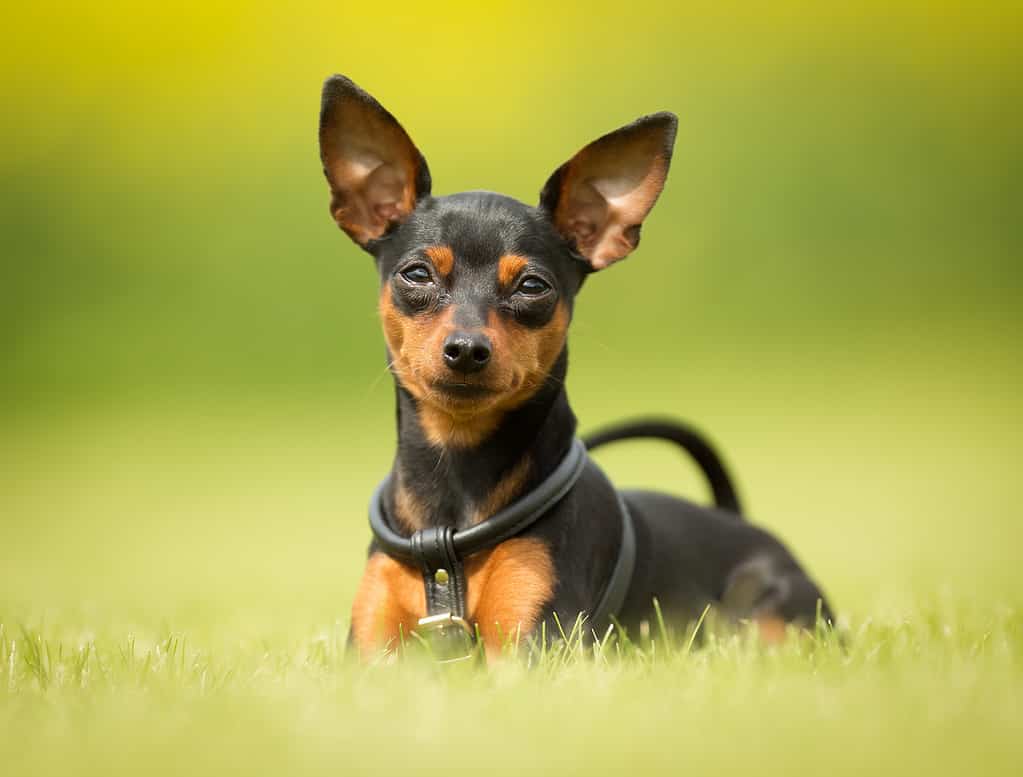
The miniature pinscher breed stops growing around 12 months of age.
©Bigandt_Photography/iStock via Getty Images
Miniature pinscher bodies usually grow until the dog is nearly a full year old. Though the pups have their adult teeth by the time their bodies are done growing, their energy won’t stop for another year after their skeleton is fully developed.
“Miniature pinschers puppies will reach sexual maturity around six months of age, but won’t stop growing until they’re closer to 10 to 11 months old,” said Chyrle Bonk, DVM of PetKeen.com. “By then, they will be about 10 to 12 inches tall and have a healthy weight of 8 to 12 pounds. Most min pins will make it into their teenage years with a life expectancy of 14 to 16 years.”
How Big Will My Miniature Pinscher Be When It’s Fully Grown?
While overall size, height, and weight will depend on the individual dog, miniature pinschers within the breed standard usually weigh between eight and 10 pounds. As AZ Animals’ expert, Dr. Bonk, stated above, the dogs usually stay between 10 and 12 inches in height, with the breed’s standard maxing out around 12.5 inches.
In addition to an individual dog’s genetics, exercise and nutrition play a massive role in healthy growth and development. Your vet can help determine if your min pin is hitting their growth milestones or coming in above/below the thresholds.
When Should My Miniature Pinscher Be Spayed or Neutered?
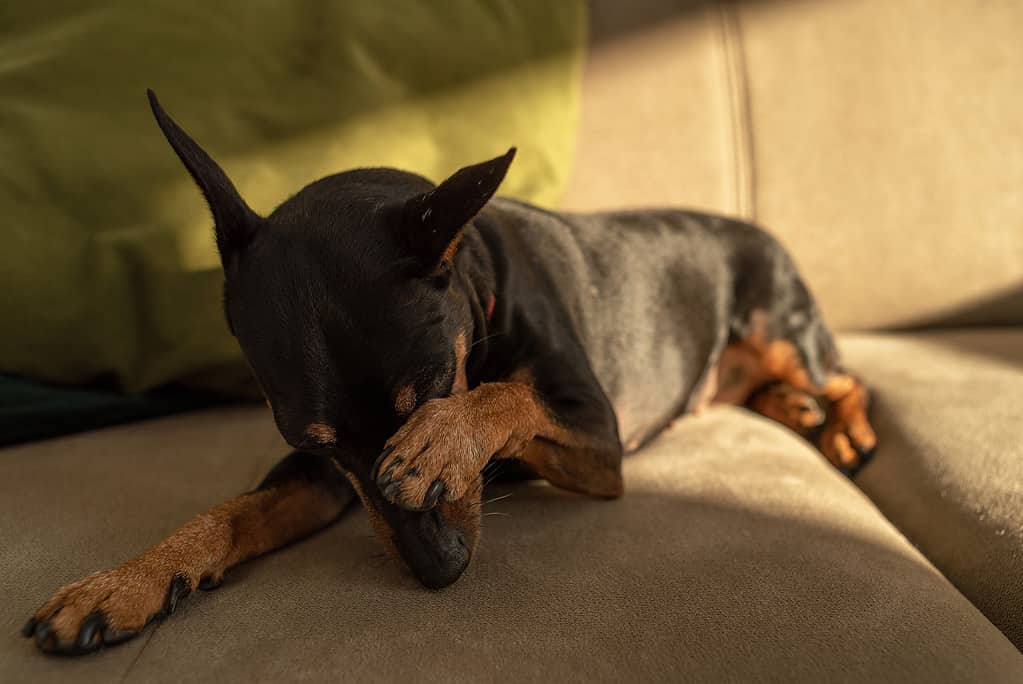
Toy breed dogs reach skeletal maturity before large breeds, so they’re able to get spayed or neutered earlier.
©Sirina85/iStock via Getty Images
Spaying (for females) and neutering (for males) yield several noticeable benefits for miniature pinschers. For families who don’t want to breed their female min pin, they won’t have to navigate the messiness of heat cycles. Fixing your miniature pinscher may also prevent several types of reproductive organ cancers or health issues.
Smaller dog breeds can be fixed before larger breeds, which take longer to reach skeletal maturity. Being a toy breed, miniature pinschers can get spayed or neutered at around six months old. Owners should always consult their vet before the procedure to talk about extenuating health circumstances, risks, and how the surgery will affect their dog.
When Should My Miniature Pinscher Be House Broken?
Consistency and patience are key when house training any dog. Miniature pinscher owners won’t need much. Min pins have both obedient and emotional intelligence that helps them learn how to potty train quickly. However, they are a toy breed — meaning they will need more frequent bathroom breaks than some other breeds.
Potty training can start as soon as you bring your min pin home. The most common form of potty training is anticipating their potty needs at regular intervals. This includes:
- When they wake up in the morning.
- When they wake up from a nap.
- After every meal.
- After playtime.
- Before you leave the house.
- After you come back to the house.
- Before bedtime.
- After they’ve drunk a significant amount of water.
- After training.
Schedules come in handy when potty training dogs. The quicker you can establish a routine, the quicker your min pin will know what to do and listen to their own body. If you choose to train your pup with external stimuli (like a bell on the door or a speaking button), make sure you remain consistent in using that as well.
If you leave your min pin puppy in the house unattended while they’re potty training, have patience. Usually, puppies can only hold their bladder around how many months old they are. This generalized number is also used for medium and large-sized dogs, so your six-month-old miniature pinscher may only have the ability to hold its bladder for four hours instead of six.
Accidents happen. Ensure you have the proper clean-up tools to rid the home of the smell and ammonia. This cleans the floor and removes the “marking” smell so your min pin won’t choose to potty there the next time they need to go.
When Should My Miniature Pinscher Stop Eating Puppy Food?

When changing from puppy to adult food, make a slow transition to help your dog’s stomach adjust.
©Tatyana/iStock via Getty Images
The majority of min pin owners suggest feeding the breed a premium brand of dry food like Taste of the Wild Appalachian Valley, Purina Pro Plan Focus Puppy, and Blue Buffalo Life Protection. These puppy foods have a unique combination of fat, carbs, protein, and calcium to continue their growth until about a year old. By this time, their nutrient needs have changed significantly enough from puppyhood that they’ll need a new recipe with different levels of nutrients.
When you change your miniature pinscher’s food over from puppy to adult recipe, remember to take it in steps. Switching “cold turkey” can cause gastrointestinal tract issues and doesn’t give the stomach enough time to build up the helpful bacteria it needs to digest.
Remember, switching your miniature pinscher’s food too early or too late can impact their development. Always consult your vet if and when you need help choosing what to feed your dog.
When Will My Miniature Pinscher Start Losing Teeth?
According to Dr. Sabrina Kong of WeLoveDoodles.com, min pins go through a teething phase like all other breeds.
“They start losing their baby teeth around three to four months, which are replaced by permanent adult teeth by six to seven months,” Dr. Kong informed AZ Animals.
During your miniature pinscher’s teething phase, they’ll be in a lot of discomfort. After all, they’re growing an additional 14 teeth. To help ease the pain, consider offering your pup some cold or soft teething toys. Frozen chew toys, mini bagels, or fruit provide an activity to busy your pup while you protect the legs, sides, and bottoms of furniture and upholstery.
When Should I Start Training My Miniature Pinscher?
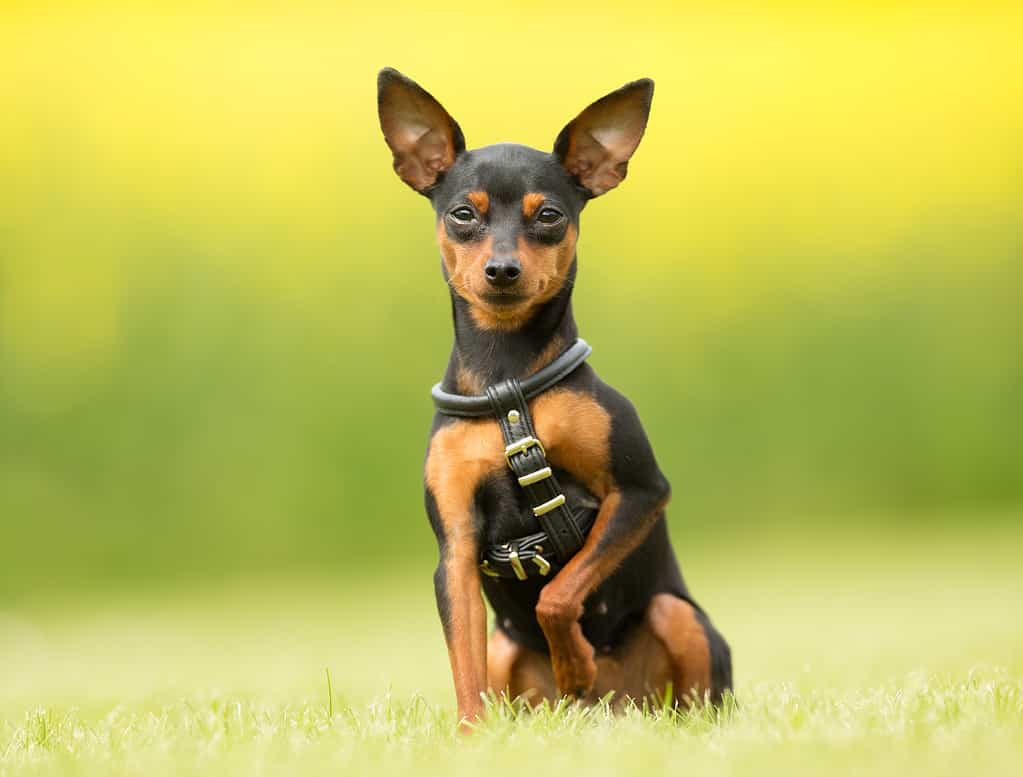
Min pins need socialization early to ensure they don’t develop fear or aggression toward strangers.
©Bigandt_Photography/iStock via Getty Images
Miniature pinschers are smart dogs, so you can start training them right away. Starting early establishes great behavior and habits — curbing the temptation in “toddler years” to develop behavior issues and stubbornness.
Because miniature pinschers have a compliant and eager-to-please nature toward their families, their obedience training comes with relative ease. They’re guarded toward and wary of strangers by nature, so socialization remains vital in the first few months of life. Miniature pinschers will seek to protect their family from perceived threats as much as possible — which makes establishing boundaries in puppyhood all the more important.
What Cues Should I Teach My Miniature Pinscher First?
When embarking on training with your min pin, focus on several foundational cues first. For example, sit, stay, and come remain the most vital and foundational commands that the rest of the training will build on.
The cues you teach first also depend on the type of lifestyle you want to lead. If you’ve adopted a miniature pinscher from a championship lineage to show them, you’ll want to start obedience training right away (after potty training and leash training, of course). Conversely, if you’ve adopted your min pin to be a loving family dog, you may want to start training them how to gently take treats from tiny hands, to get on and off furniture, and how to regulate their emotions or remove themselves when situations get too hyper.
For miniature pinschers, and any dog breed, positive reinforcement remains the best way to train.
When Will My Miniature Pinscher Calm Down?
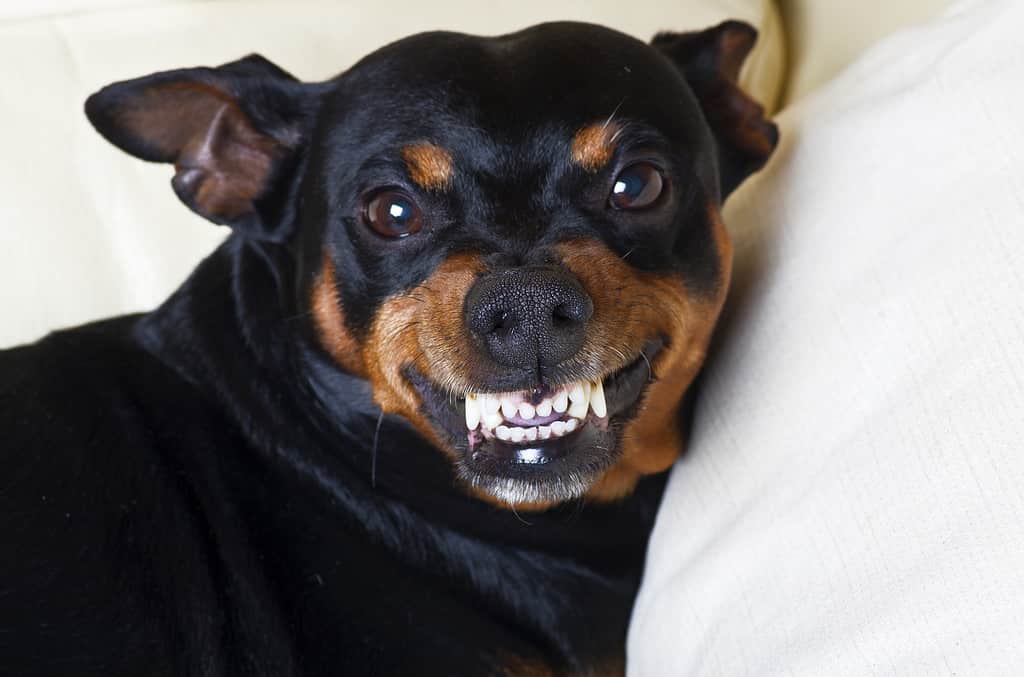
Miniature pinschers are ready to protect their family at a moment’s notice.
©Photopips/iStock via Getty Images
Miniature pinschers become the life of the party the moment you bring them home — especially if they’re the only dog in the house. These lively dogs love to play, and a short walk might not be enough to tire them out when they’re puppies.
While the exact timeline of your miniature pinscher calming down depends on the individual dog, your lifestyle, and external stimuli, you can generally expect the breed to mellow out around the 24-month mark. At two years old, your pup is fully grown, understands how the world works around them, and has a routine (for the most part).
Just because your pup calms down, though, doesn’t mean they’ll lose their fun-loving, energetic personality. You just may chase them around the table or yard a little less… which is a benefit in itself!
Common Health Issues Your Miniature Pinscher Might Experience
While generally healthy, miniature pinschers have a predisposition to suffer from several unique disorders. Vet checkups are vital to ensure your miniature pinscher is growing healthy and strong — and early signs are detected if they exist.
Some common health issues with miniature pinschers to watch out for include:
- Luxating patellas, a disorder in which the kneecap dislocates from the groove of the femur.
- Cervical disc disease, or getting a “slipped disc,” which results in neck pain and/or injury.
- Legg-Calve-Perthes disease, a disease in which the hip end of the femur doesn’t receive a proper amount of blood flow.
- Epilepsy, a brain disorder that causes recurrent seizures.
Consult your vet if you see your miniature pinscher behaving out of the ordinary, whether it’s a funny walk, a mood shift, or an apathy for activities they once enjoyed.
Pictures of Miniature Pinscher as Puppies
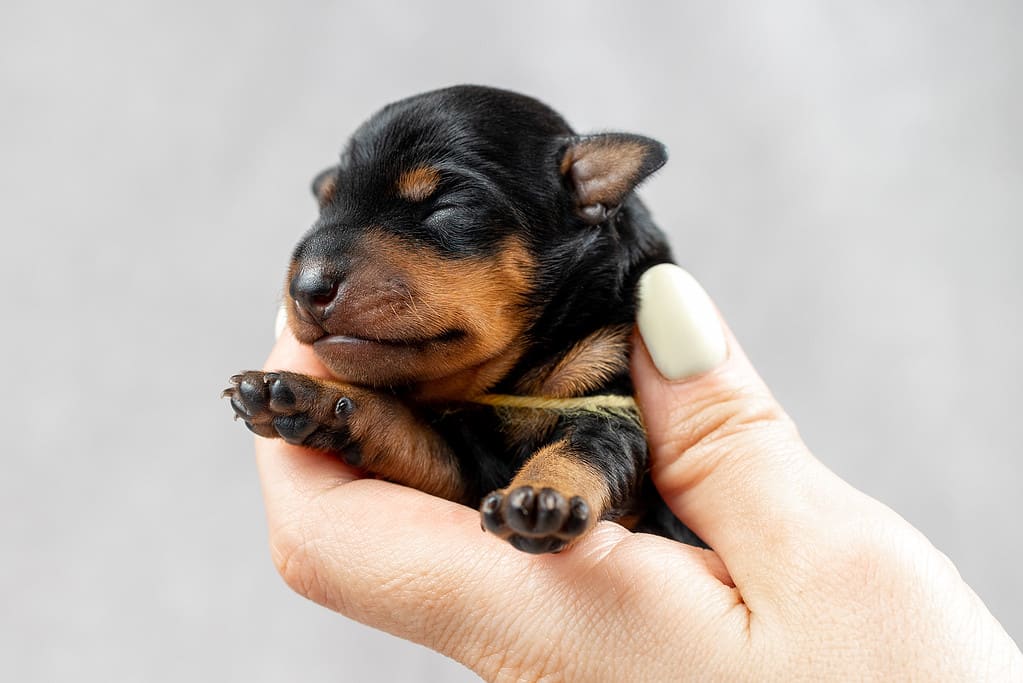
When born, miniature pinschers weigh only a few ounces.
©Evgenia Glinskaia/iStock via Getty Images
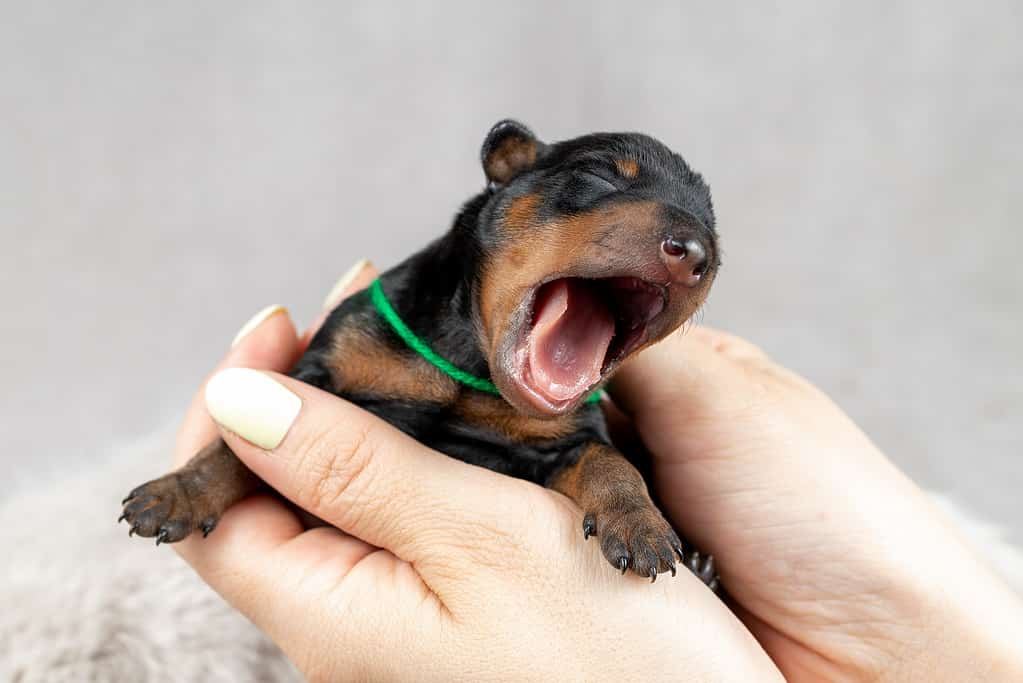
The litter size of a miniature pinscher ranges between three and six puppies.
©Evgenia Glinskaia/iStock via Getty Images
Pictures of Miniature Pinscher at 6 Months
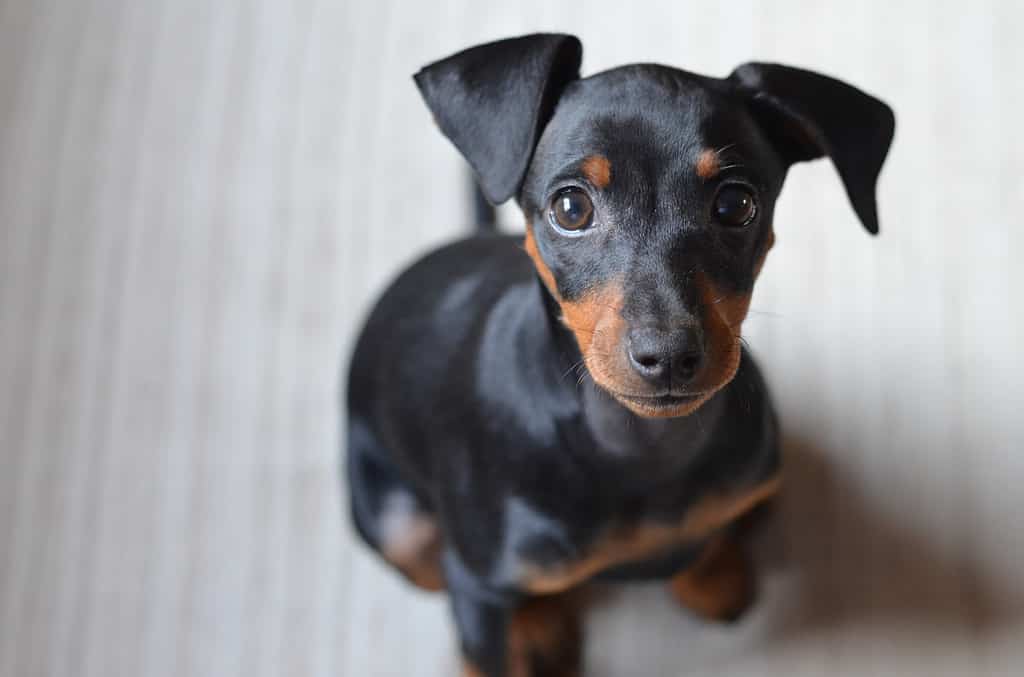
You can spay min pin females before their first heat cycle around the six month mark.
©andrea-goitia/iStock via Getty Images

Exercise for a miniature pinscher puppy includes walks, playtime inside, and socialization with other humans and animals.
©Evgenia Glinskaia/iStock via Getty Images
Pictures of Fully Grown Miniature Pinscher
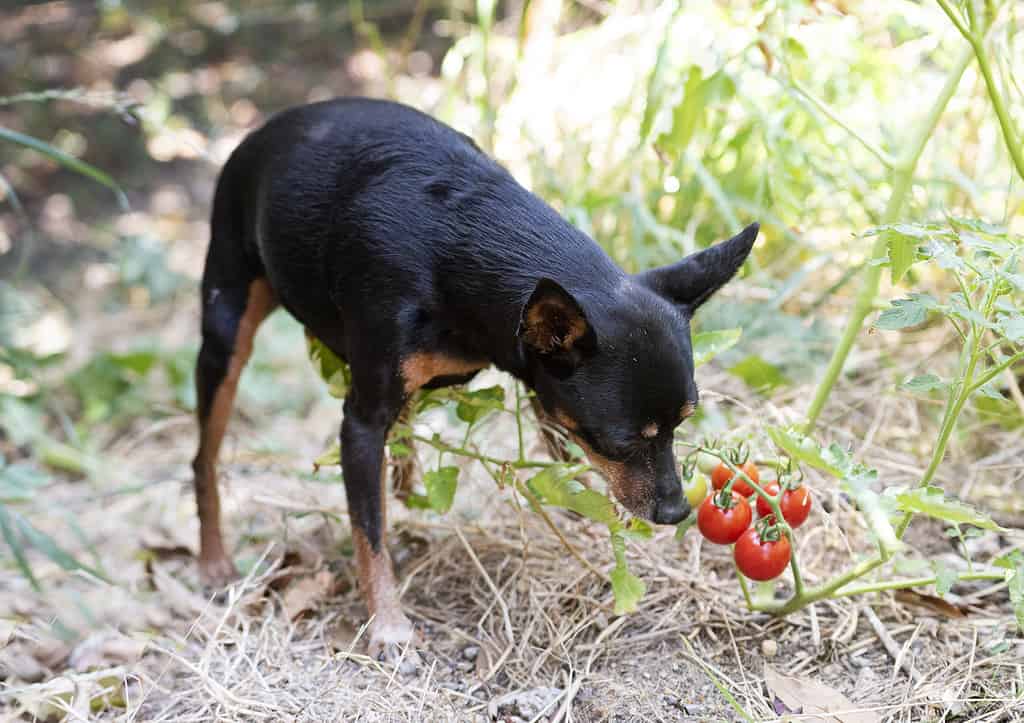
Don’t let your miniature pinscher eat green tomatoes, as they can be poisonous in large quantities.
©cynoclub/iStock via Getty Images

Miniature pinscher dogs have boundless energy for their first two years of life.
©Olena Bondarenko/iStock via Getty Images
Ready to discover the top 10 cutest dog breeds in the entire world?
How about the fastest dogs, the largest dogs and those that are -- quite frankly -- just the kindest dogs on the planet? Each day, AZ Animals sends out lists just like this to our thousands of email subscribers. And the best part? It's FREE. Join today by entering your email below.
Thank you for reading! Have some feedback for us? Contact the AZ Animals editorial team.

